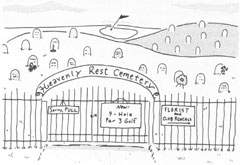Why do Clocks run clockwise? (14 page)
Read Why do Clocks run clockwise? Online
Authors: David Feldman

How Do They Shell Pine Nuts?
With great difficulty.
Paul Wallach, who hosts a popular interview show in Los Angeles concerned largely with food and restaurants, told us that this Imponderable had stumped him for a long time. What machine, he wondered, could possibly be fitted to work on pine nuts?
It turns out that no machine works consistently well in shelling pine nuts. Most pine-nut processors use almond shellers, which do only a decent job of shelling without ruining the nut-meat.
Many of the pine nuts from China are shelled by hand. Or rather, by a hammer held by a human hand. Not high-tech. Not fast. Labor intensive. But effective.
Submitted by Paul Wallach, of Los Angeles, California
.
94 / DAVID FELDMAN

How Can Owners of Small Cemeteries Make
Money? How Can They Plan Their Finances When
They Have to Wait for People to Die Before They
Derive Income?
We were asked this Imponderable several times on radio talk shows.
And we were stumped. The income of a small cemetery owner must be severely limited by the population the cemetery serves. In many cases, privately owned cemeteries and funeral homes even in the smallest towns must “compete” against their church-owned or municipal counterparts. Church-owned cemeteries often charge only for the cost of digging a grave; the privately owned cemetery charges Tiffany prices in comparison.
We found out that more than a few cemetery owners in small towns are not millionaires. Many funeral directors and a few cemeterians need second jobs to provide more income. How do the small cemeterians survive? Are there any (legal) ways of “drumming up” business?
WHY DO CLOCKS RUN CLOCKWISE? / 95
We were lucky enough to find Howard Fletcher, the chairman of the Small Cemetery Advisory Committee of the American Cemetery Association. Mr. Fletcher, who owns a memorial park in Muscatine, Iowa, helps fellow small cemeterians contend with the very financial problems we have discussed. Despite all the jokes about the business (such as “
everybody
is a potential customer”), a small cemeterian must do more than sit around and wait for people to die in order to survive. Howard Fletcher is unusually frank and unsanctimonious about his profession, and unashamed about the methods he uses to maximize his income. He developed a pamphlet called “50 Sources of Income for Small Cemeteries,” from which most of the material below was adapted.
Within Fletcher’s fifty sources of income are at least five broad categories: preselling; upgrading; maximizing underutilized assets; creative financing; and expanding services and products.
Preselling
To Fletcher, this is the key ingedient in a successful small cemetery operation. Most funeral directors have to wait until a death before seeing any income. Fletcher tries to sell his community on the advantages of buying space, vaults, caskets, and even memorial markers
“preneed” rather than “at need.” He has many arguments in his arsenal: a preneed purchase saves the bereaved family from the emotional strain of making funeral arrangements at the time a loss occurs; the decision can be made at the home of the buyer; prices will be lower now than when bought in the future; no cash is necessary right away, while most funeral directors would require some cash
“at need”; making arrangements now will provide the buyer with peace of mind, not only for him or herself, but in knowing that the family will not be saddled with the unpleasant task; spouses can make decisions about funeral arrangements together; terms are ne-gotia
96 / DAVID FELDMAN
ble—the buyer is likely to have more leverage when he or she is hale and hearty. To quote Mr. Fletcher: “It is not a question of if these arrangements will be made, it is only a question of who is going to make them and when!”
Here are some of the successful variations of preneed selling: 1. Sell child burial protection. Child protection doesn’t cost much, but it does provide great cash flow. By the time the child is likely to die, compound interest has made this presell very profitable.
2. Presell grave opening and closing charges.
3. Offer one free burial space or two-for-one sales to married couples. Presumably, married couples want to be buried together, so the free space for one turns out to be the same deal as the two-for-one—these offers are always nonassignable and nontransferable (thus solving the possible divorce problem).
Upgrading
1. Sell marker refinishing kits. Bronze markers often tarnish because of oxidation.
2. Sell granite bases as upgrades from concrete bases.
3. Sell larger memorials.
4. “Reload.” Use existing customers as a base to sell new or improved products. This is one reason cemeterians like to deliver by hand all deeds and official papers. They can discreetly get referrals or find family members who have not yet made funeral plans.
Fletcher issues two newsletters per year with return cards and pitches for upgrading products.
5. Sell wreath and grave coverings for Christmas, Memorial Day, and other holidays.
6. Sell vesper lights.
7. Sell carillon chimes with the donor’s name on plaque.
WHY DO CLOCKS RUN CLOCKWISE? / 97
Maximizing Underutilized Assets
1. Launch a lawn-care business to more fully utilize landscaping equipment.
2. Sell double-depth privileges.
3. Grow and sell sod.
4. Raise and sell nursery stock from open land.
5. Cut and sell firewood from open land.
6. Sell excess trees on property.
7. Lease extra acreage to farmers.
8. Sell excess materials from graves as fill dirt.
Creative Financing
Many of these tips consist of charging separate fees for services that might or might not be included in the usual package deal: 1. Charge a filing and recording fee.
2. Charge for deed transfer and replacement.
3. Offer discount for cash payment of open accounts in order to generate cash flow.
4. Sell accounts receivable for cash flow.
5. Charge interest on house accounts.
6. Increase price of lots by having care charge paid separately.
7. Increase price of memorial by having installation and care charges paid separately.
8. Sell for allied businesses, such as monument dealers.
9. Sell extra-care charge for special care.
10. Where cemetery has historic value, apply for federal, state, or local registry in historical society for funding purposes.
11. Hire professional collectors for delinquent accounts.
12. Offer a discount on a new marker if purchased within one month of burial.
98 / DAVID FELDMAN
Expanding Services and Products
Here are some of the more creative ideas, all potentially practical: 1. Start a pet cemetery, with preneed and at need sales.
2. Manufacture vaults.
3. Build a funeral home that offers preneed as well as at need follow-up.
4. Start a trailer park on extra acreage where feasible.
5. Rent the chapel tent for weddings and lawn parties.
6. Raise and sell livestock.
7. Develop a flower shop.
8. Sell garden features and entrance features.
9. Sell trees—lining drives and/or walks.
10. Sell benches in cemetery.
11. Sell stained-glass windows.
12. Sell pews in chapel.
13. Sell furniture in mausoleum or committal area.
Some of these “money-making tips” might be offensive to your sensibilities. The image of a trailer park next to the memorial park is less than pleasing, and the thought of discussing preneed services at your kitchen table might dull the appetite a bit. The alternative, though, is usually a full-court press at the time of death.
Howard Fletcher is providing a service, but is also willing to admit that he is in business to make money. He wants the public to know what the business is like, so that the public can understand the industry’s problems. Most small cemeteries make less than $100,000
in sales per year and conduct fewer than 150 burials. In order to survive, the small cemetery owner must often hustle as aggressively as any other salesperson.
WHY DO CLOCKS RUN CLOCKWISE? / 99

Why Are Most Homes Painted White?
Most homes in the United States have always been painted white.
Paint was first used as a preservative as much as an aesthetic expression. White was evidently believed to be more durable than other mixtures, but there were also historical reasons for its popularity.
White was associated with the classic Greek and Roman architectural forms. Furthermore, Puritans viewed color as frivolous; the “serious-ness” of white continued to appeal to Americans as late as the mid-nineteenth century.
In 1842, American architect Andrew Jackson Downing launched an attack against the color white for homes (a large proportion of American homes were then painted white with green shutters): There is one colour…frequently employed by house painters, which we feel bound to protest against most heartily, as entirely unsuitable, and in bad taste. This is white, which is so universally 100 / DAVID FELDMAN
applied to our wooden houses of every size and description. The glaring nature of this colour, when seen in contrast with the soft green foliage, renders it extremely unpleasant to an eye attuned to harmony of coloring, and nothing but its very great prevalence in the United States could render even men of some taste so heedless of its bad effect.
Downing argued for muted earth tones as the best alternative to white, and for a while his aesthetic was influential, especially after the paint industry developed the technology to premix paints of various shades and ship them safely throughout the country by rail.
(Until after the Civil War, local painters had had to mix dry colors with lead and oil to create nonwhite shades of paint.) In the late nineteenth century, white houses became the vogue once again, and although tastes in home colors have gone through many cycles in the past hundred years, white has never become un-fashionable. A survey of paint authorities yielded some reasons for its endurance as our most popular color:
1. The choice of white can never be a disaster. Although you risk seeming unchic by avoiding a more “daring” color, you can never be accused of tackiness. Shari Hiller, the color stylist for Dutch Boy Paints, thinks this is the most important reason for the popularity of white:
I have found in putting together color cards for our brands, that the homeowner is pleading for suggestions in the exterior color scheme areas. When we finally answer our customers’
needs and provide them with enough advertising, photos, and helpful suggestions that they feel more comfortable making a color decision, I think we may see many other colors gaining in popularity.
2. White has so many pleasant associations. White connotes cleanliness, peace, strength, and purity.
3. White is classic. Much like the basic black dress, white is unlikely ever to go out of style. Our president, after all, doesn’t live in the Puce House. Of our nation’s major monuments, only the Statue of Liberty isn’t white (and the statue, of course, was a French import).
WHY DO CLOCKS RUN CLOCKWISE? / 101
4. White goes well with other colors. White mixes well with any shutter trim the homeowner desires, and with all roof colors.
Submitted by Mark Carroll, of Nashville, Tennessee
.
Why Is One Side of Reynolds Wrap Aluminum Foil
Shiny and the Other Side Dull?
Grown people, though no personal friends of ours, have been known to argue about whether the shiny side of Reynolds Wrap is supposed to cover the food or to be the side exposed to the outside elements.
According to the folks at Reynolds Metals, it makes little difference which side of Reynolds Wrap you use. There is a slight difference in the reflectivity of the two sides, but the difference is so small that it can only be measured by laboratory instruments. Nikki P. Martin, Reynolds’s consumer services representative, puts it succinctly if self-servingly: “Both sides do the same fine job of keeping hot foods hot, cold foods cold, wet foods wet, dry foods dry and all foods fresh longer.”
